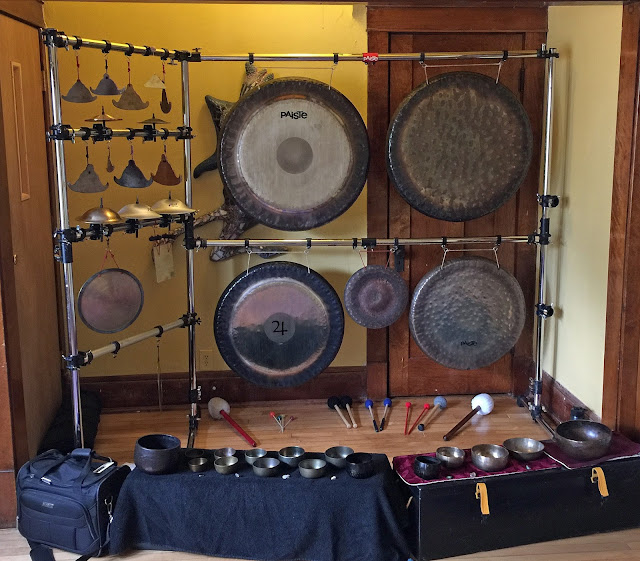Silence As A Tool
I have to thank my good friend, Kenny Kolter, for the idea for today's post. We were talking about using silence as a tool. It's an interesting concept that I fear many people making music, especially Gong & Bowl players, don't understand.
Into The Realm Of Silence
Silence is remarkable in its ability to actually reveal sound. So much music today, and much of the Gong playing I hear, is a non-stop barrage of sound. In that capacity, it's virtually impossible to distinguish individual sounds, to really hear what is going on. The human mind has the remarkable ability to shut off unrelenting sounds, or noise, after a short time.
Think of the street construction in front of your house. At first you find it irritating and loud, but after a while, your mind tunes it out and you barely notice it anymore. The same with the neighbor's lawn mower, busy street traffic, or living by an airport. All these extraneous sounds are noisy and irritating when we first encounter them, but we adapt and learn to ignore them.
The same thing happens with continual music, like drones or continual Gonging. The mind shuts it out. Now in some circumstances, this is the desired experience—no mind. I look at the Kundalini style of Gonging, with its continuous, loud sound, and find it alien from my own style. It's neither bad nor good, just different. And for those who practice and/or follow this style of Gonging, I say, “Go for it.” It's just not my thing.
So What Is “My Thing”?
This is a great question, and one that I think about everyday, because what I do is continually evolving. I used to play a lot of continual Gonging on the large Gongs. I did that for a few years, but then I thought that there must be something more than this. But what? One of the 1st steps was to learn to just stop playing the Gongs. That's it. Just stop.
Now when you are used to just playing this continual sound, like an ever cresting ocean wave, the idea of just stopping in the middle is daunting. Will the people wonder what's going on? Will I lose them if I stop? These, and many other questions, popped up in my mind. But through all this, there was a small voice that said, “Trust this.” And that small voice speaks up a lot when I reach an impasse. “Trust what you are feeling.”
What I found was that stopping allowed the sound to take shape, to be recognizable. I could see/hear the different sounds clearly. And this silence let the sounds breathe. They also let the ear and the mind breathe and rest. But it wasn't easy. It took a lot of trust.
Trust in me.
Trust in the sounds.
Trust in the people listening to the sounds.
The Experience Of Silence
And through all this, I came to both trust and enjoy the silence. I liked how I could use it to shape the sound, like a sculptor uses a chisel against the stone, shaping it into form. And I liked how it let everything breath.
Concurrent with this was my moving away from playing just Gongs, adding various bowls, bells, and other instruments to bring in not only different sounds, but different sound textures. While my instruments are not tuned to a Western scale, I have various sets of Bowls and Bells that I put together into melodic sets. I also have different instruments that are centered around the same pitch. For example, a copper clad bell, a Burma Bell, a Bell Cymbal, and a Gong. While the pitch is the same, the texture/timbre is different. I like this.
And with all of this there is silence. I like letting one sound fade away into nothingness, waiting a bit more, then producing the next sound. I feel that this gives both the the mind and body a chance to experience and digest one sound before having to process another.
Exercise
Take 1 Gong/Bowl/etc and play it for a while, then stop. Let the sound completely fade away before you start playing again. Stop again after a while, let the sound fade away, but when you are ready to start, count to 5 or 10 then start.
Count how long you play, say to 20, then stop and count the same before starting again. Change your count, both longer and shorter. Listen to how this shapes the sound (it also shapes the silence!). Learn to feel and experience the silence as much as you do the sound—most of us only experience the sound.
It took years of experimentation and maturity to evolve to the place I am in today. It takes dedicated work to learn how to use both sound and silence as tools. Take the time. You will be better off for it.
~ MB
Into The Realm Of Silence
Silence is remarkable in its ability to actually reveal sound. So much music today, and much of the Gong playing I hear, is a non-stop barrage of sound. In that capacity, it's virtually impossible to distinguish individual sounds, to really hear what is going on. The human mind has the remarkable ability to shut off unrelenting sounds, or noise, after a short time.
Invite silence into your playing. Photo © Michael Bettine
Think of the street construction in front of your house. At first you find it irritating and loud, but after a while, your mind tunes it out and you barely notice it anymore. The same with the neighbor's lawn mower, busy street traffic, or living by an airport. All these extraneous sounds are noisy and irritating when we first encounter them, but we adapt and learn to ignore them.
The same thing happens with continual music, like drones or continual Gonging. The mind shuts it out. Now in some circumstances, this is the desired experience—no mind. I look at the Kundalini style of Gonging, with its continuous, loud sound, and find it alien from my own style. It's neither bad nor good, just different. And for those who practice and/or follow this style of Gonging, I say, “Go for it.” It's just not my thing.
So What Is “My Thing”?
This is a great question, and one that I think about everyday, because what I do is continually evolving. I used to play a lot of continual Gonging on the large Gongs. I did that for a few years, but then I thought that there must be something more than this. But what? One of the 1st steps was to learn to just stop playing the Gongs. That's it. Just stop.
Now when you are used to just playing this continual sound, like an ever cresting ocean wave, the idea of just stopping in the middle is daunting. Will the people wonder what's going on? Will I lose them if I stop? These, and many other questions, popped up in my mind. But through all this, there was a small voice that said, “Trust this.” And that small voice speaks up a lot when I reach an impasse. “Trust what you are feeling.”
What I found was that stopping allowed the sound to take shape, to be recognizable. I could see/hear the different sounds clearly. And this silence let the sounds breathe. They also let the ear and the mind breathe and rest. But it wasn't easy. It took a lot of trust.
Trust in me.
Trust in the sounds.
Trust in the people listening to the sounds.
The Experience Of Silence
And through all this, I came to both trust and enjoy the silence. I liked how I could use it to shape the sound, like a sculptor uses a chisel against the stone, shaping it into form. And I liked how it let everything breath.
Concurrent with this was my moving away from playing just Gongs, adding various bowls, bells, and other instruments to bring in not only different sounds, but different sound textures. While my instruments are not tuned to a Western scale, I have various sets of Bowls and Bells that I put together into melodic sets. I also have different instruments that are centered around the same pitch. For example, a copper clad bell, a Burma Bell, a Bell Cymbal, and a Gong. While the pitch is the same, the texture/timbre is different. I like this.
And with all of this there is silence. I like letting one sound fade away into nothingness, waiting a bit more, then producing the next sound. I feel that this gives both the the mind and body a chance to experience and digest one sound before having to process another.
Exercise
Take 1 Gong/Bowl/etc and play it for a while, then stop. Let the sound completely fade away before you start playing again. Stop again after a while, let the sound fade away, but when you are ready to start, count to 5 or 10 then start.
Count how long you play, say to 20, then stop and count the same before starting again. Change your count, both longer and shorter. Listen to how this shapes the sound (it also shapes the silence!). Learn to feel and experience the silence as much as you do the sound—most of us only experience the sound.
It took years of experimentation and maturity to evolve to the place I am in today. It takes dedicated work to learn how to use both sound and silence as tools. Take the time. You will be better off for it.
~ MB
Chop Wood / Carry Water / Play Gongs™ / Invite Silence In




Comments
Post a Comment